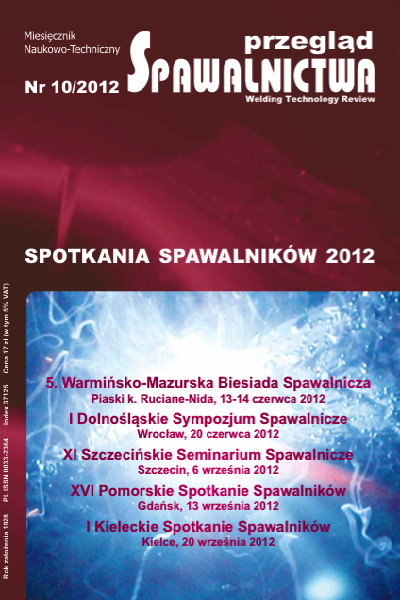Analiza technologii spawania laserowego materiałów trudnospawalnych
Main Article Content
Abstract
W artykule przedstawiono wyniki badań nieniszczących, metalograficznych oraz pomiary mikrotwardości złączy korpusu z żeliwa sferoidalnego spawanego laserowo. Na podstawie badań stwierdzono, że techniki spawania laserowego mogą być z powodzeniem stosowane w przemyśle motoryzacyjnym, ponieważ mogą zapewnić wysokie wymagania stawiane konstrukcjom spawa- nym, przy jednoczesnym zachowaniu wysokiej wydajności. Udowodniono, że proces spawania żeliwa, które jest materiałem powszechnie uznawanym za trudnospawalne, przy odpowiednim doborze metody oraz parametrów spawania laserowego, można realizować. Potwierdzono tym samym przydatność techniki spawania laserowego z materiałem dodatkowym o wysokiej zawartości niklu, nadającego spoinie plastyczność, przy jednoczesnym obniżeniu twardości, ograniczeniu występowania pęknięć i porowatości w złączach. Stwierdzono słuszność zastosowania gazu osłonowego helu, który dzięki swoim właściwościom ochronnym pozwala uzyskać najlepszą jakość spoin dla materiałów trudnospawalnych. Mikrostruktura materiału rodzimego składa się z ferrytu, perlitu oraz wydzieleń grafitu kulkowego. Mikrostruktura złącza spawanego potwierdziła występowanie kruchych martenzytycznych obszarów w strefie wtopienia i strefie wpływu ciepła. Prowadzi to do uzyskania wysokiej twardości materiału, przy jednoczesnym spadku udarności.
Analysis of the laser welding technology of poorly weldable materials
The results of non-destructive testing, metallographic, and microhardness measurements of housing joints made of ductile iron joined by laser-welding have been presented in the paper. Based on extensive research it has been discovered, that the laser welding technique can be successfully used in the automotive industry, and thanks to its unique properties, are able to provide the high demands of welded constructions, while maintaining high efficiency of the process. It has been proven, that the process of welding of cast iron, which is a material commonly considered to be difficult weldable, with the appropriate selection of method and laser welding parameters can be easily performed. Thus it was confirmed the usefulness of laser welding techniques with filler material, enriched with a high content of nickel, which causes plastici- ty of the weld, while reducing hardness, cracks and poro- sity in the joints. It was also discovered that using helium as the shielding gas improves the laser welding process, because its competitive protective properties, allows to obtain the best quality of welds for materials which weldability is difficult. Microstructure of base material consists of ferrite, perlite and secreted nodular graphite, while the microstructure of the joints confirmed the presence of brittle martensitic areas inside fusion zone and heat affected zone.
Downloads
Article Details
Creative Commons CC BY 4.0 https://creativecommons.org/licenses/by/4.0/
Welding Technology Review (WTR) articles are published open access under a CC BY licence (Creative Commons Attribution 4.0 International licence). The CC BY licence is the most open licence available and considered the industry 'gold standard' for open access; it is also preferred by many funders. This licence allows readers to copy and redistribute the material in any medium or format, and to alter, transform, or build upon the material, including for commercial use, providing the original author is credited.
References
Klimpel A.:Technologie laserowe w spawalnictwie, Wyd. Polit. Śląskiej, Gliwice, 2011.
Kusiński J.: Lasery i ich zastosowanie w inżynierii materiałowej, Wydawnictwo Naukowe Akapit, Kraków, 2000.
Jóźwicki R.: Technika laserowa i jej zastosowania, Oficyna Wydawnicza Politechniki Warszawskiej, Warszawa, 2009.
Poradnik Inżyniera Spawalnictwo Tom II, WNT (pod red. J. Pilarczyka), Warszawa, 2005.
Dobrzański L.: Metalowe Materiały Inżynierskie, WNT, Warszawa, 2004.
Internet: www.specialmetalswelding.com, 04.05.2011.
